Covid
19 update: things are improving, most restrictions
are gone. The 'Paalkampeerplaatsen'
have been shut down for good, shops and
sidewalk cafe's are open again but the
coffeemachine in the back of a supermarket is
still not in operation
Cycle touring the Netherlands for foreigners
definitely not by the Dutch
Tourist board
(c)
m.s.gerritsen 2003-2023
(please note that any disclaimer by
any lawyer ever probably applies to this page
(and besides it wasn't me, honest!))
Cycling
is
for the Dutch a way of life. Everyone learns to
cycle in infancy, and for short journeys cycling is
the preferred mode of transport. If you go shopping,
if you have to go to school, if you have to answer
questions in parliament (unless you've got your bike
nicked like the minister for the Justice department
;) ) or if you are planning a pub crawl the
bicycle can't be beat. Some might even ride a bike
for sports or as a way to keep fit, but they are a
fringe minority with so many normal bikes on
the road. In primary-school we have all done sums
involving a cyclist at 18 km/hr, and most Dutchmen
will consider this quite fast and long enough.
Theft
The
Dutch ride mainly roadster (sit up and beg)
bicycles, and these are supposed to keep working
without maintenance. In fact maintenance is a
liability, as a new rear tyre increases the risk of
theft. Bike theft in Holland is a real problem and
the most popular crime, committed either by
addicts looking for money, organised gangs from
former east bloc countries or by those who have
missed the last bus home. In some circles it is even
considered normal to steal a similar bike if you
find your own bike gone! In 2023 928.000 (2006
was 760.000) bikes were reported stolen, which is
about 4% of all cycles in the Netherlands! Things
aren't improving, allthough perhaps E-bikes
are a now more likely target.
I
would suggest to
- Bring
a
lock, and lock the bike to something solid. And
check that it is solid, and not a bike rack that
has already been cut to release a previous bike
- Not
to park the bike in the city streets at night
- Not
to bring your shiny bike to large cities with a
population of drug addicts (walk or use trains,
trams or buses if you can work out how the ticket
system works. Taxi's are very expensive, and
-politely put- the quality and morality of the
drivers is variable)
- Only
park
your
bike at railway stations if there is a guarded
facility (check the opening hours though)
- Not
to expect anything from the police (okay, perhaps
a cup of coffee)
- Oh
by the way, if you apprehend a thief be nice to
him. Only police or criminals are permitted to use
force, ordinary persons will be prosecuted.
Arrival
If you arrive by plane, but want to start
cycling from Schiphol Airport, there are routes for
traveling cyclists leading out (or for underpaid
wageslaves going the other way to show up for work).
If you want to continue by train there are (yellow)
ticket machines situated in the baggage claim area, so
you can get a ticket before your bags arrive. If you
leave the bike packed you won't need a separate ticket
for it. The train station is underneath the departure
hall, check the large yellow noticeboards for the
right station platform. The airport train to Amsterdam
is ideal hunting grounds for pickpockets, so take
care. Ferry's from the UK land in Hook of Holland (The
new cityrail connection should take bicycles)
Europoort (nr Rotterdam) or IJmuiden (nr
Amsterdam). To get away from the airport or
harbour use the Fietsersbond routeplanner
to plan your escape.
Trains
Note:
never waste a crisis so Covid has been used to make
taking a bike on train extra difficult.)
Outside of
rush hour ( i.e 9:00-16:00 and post 18:30, this
restriction does not apply in weekends or July and
August) it is theoretically possible to take
your bike with you on the train. Getting tickets (buy
before boarding!, either online or from the machine)
can be quite a challenge though, as nearly all humans
have been replaced by ticket vendor machines. But
shouting at the machine is fine, where humans might
feel threatened. These machines probably accept your
ATM card with a four digit PIN, but don't let this
nice helpful man in line behind you run of with it! Note
that having a ticket is not enough, as to make
travel as complicated as possible you have to
validate your ticket by checking in and out before
boarding and when changing to and from regional
trains run by a different operator (NS<>
Veolia <>Syntus<>Arriva). And
you'll need a special ticket for the bike (7.50
extra), and be prepared that the designated place for
the bicycle is at the other end of the train. If you
get there before the train has left this place will
either be occupied, or to small to fit your bike. And
you are supposed to remove your bags from the bike,
but if you are a poor bewildered tourist the conductor
might turn a blind eye. Watch out for maintenance work
on the lines, which is usually done over the weekend.
The busses don't take bicycles officially, but some
drivers are more helpful than others.
If the trains actually run on time, please
don't mention it. Complaining about NS-rail is sociably much
more acceptable..
Riding
in
traffic
Dutch cyclists grow up around motorcars,
and motorists are used to bicycles. It's a jungle
out there, and the survivors have figured out a way
to stay alive. To a foreign cyclist it will look
totally accidental if the observed behaviour
coincides with the official rules of the road. You
will need some time to acclimatize (For instance
Dutch drivers appear always much more in a hurry
than laid back Americans), so don't tackle the
busiest city first if you can help it. But take it
easy the first days and you will be OK because,
although it makes a poor epitaph, most drivers now
realize that a cyclist can hit a car intentionally
head on and it will still be the car-drivers fault
by law. You'll know you're accepted into the fold
when a passing motorist brushes you with his mirror,
instead of giving you a wide berth as if you're an
alien!
- All
traffic including bicycles on equal roads from the
right has mandatory right of way, but often this
is changed with road signs and road markings.
Watch out for roundabouts, as the priority rules
are varied from region to region to catch out the
non-locals.And be wary of trucks (and cars)
on roundabouts, even if you have priority, as
keeping track of cyclists on a separate path is a
huge job with all the blindspots
- Traffic
lights are always situated before the
intersection. and we do not have ' right turn on
red'. Or if we have it, it is explicit with a sign
or with a bypass lane.
- If
you don't obstruct other traffic cyclists can ride
two abreast.
- Busy
junctions can have separate traffic lights for
cyclist. Sometimes you have to push a button to
get it's attention, sometimes the button is only
for show ;)
- In
some cities cyclists from all directions get green
simultaneously. The idea is that cyclist get along
fine with a bit of give and take.
- In
Amsterdam and some other cities you've got to
watch out for tramlines, the trams will not move
over and getting a wheel stuck in the rails will
be a crash
- Watch
out for unpredictable cyclists, as in a gaggle of
tourists on rental bikes (Amsterdam), fresh
Oriental students riding a tiny bicycle for kids
(August in university towns), or family outings
where all members assume somebody else is paying
attention
Roads
To make driving a car easier we have lots
of cycle paths:
- We
have
cycle
paths to connect villages to the nearest city. But
trying to ride from city to city can be a real
challenge, as some vital piece might be missing
necessitating a large detour without the help of
signposts,
- We
have
cycle
paths for tourist which don't go anywhere useful,
- We
have
cycle
paths which are mandatory for cyclists,
- We
have
cycle
paths which are optional for cyclists (but
forbidden for other vehicles),
- We
have
cycle
paths which can be ignored by all traffic users.
- And
the latest: bicycle highways. These are arrow
straight bikepaths through open country with all
natural windbreaks removed to make your commute
hell.
If you
encounter a blue round shield with a bicycle depicted
this means a mandatory cycle path.
If you encounter the rectangular sign
"fietspad", only cyclists are allowed to use the path,
but they are welcome to use the track adjacent.
If you encounter a red road surface with a
bike painted on it, cyclist are suggested to use that
bit, but without the round sign mentioned this doesn't
mean much.
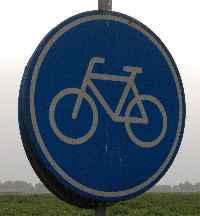  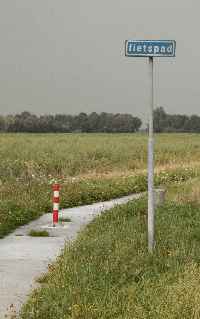
(l to r) mandatory cycling path,
definitely not a cycling path, optional cycling
path with the ubiquitous bollards
Cycle
paths
are usually constructed with concrete tiles over
tree roots, power lines and mole runs, but red
'double rolling resistance' asphalt is another
option. Posts thoughtfully placed in the middle of
the path to deter motorists (as if somebody would
ride on a cycle path by choice) add excitement at
night. And are good for 2400 trips to the ER
yearly. Or the path might end suddenly with a
90 degree turn-off shooting you in front of the
oncoming traffic which you can't see for the trees
lining the road.
Cycling
is
not allowed on Motorways and trunk roads (with or
without a hard shoulder), on roads armed with a
round red-white sign depicting a bicycle, on roads
flanked by a mandatory cycle path, on roads where
you could use the service road instead, or on the
footpath. Other laws: it is legal to tow a trailer
and we have no mandatory helmet law. Maximum width
of a bicycle is 30" (75cm), wider and you have
to follow the rules for handcarts which are
completely forgotten by motorists, cyclists and cops
alike. Bicycles should be fitted with a bell,
reflectors to the rear, sides and pedals, have a
working brake and carry (non flashing) lights after
darkness. With the exception of the lights you
should, like any Dutchmen, expect to get away
without any of the above! And in case you're
wondering what all those blabbering cyclists are
about, using a phone on a bike is -still- legal!
(Update: cycling while holding an electronic device
in your hand will be illegal as of July 2019)
For cyclist who like cheating there are
'nationale
fietsroutes'. These routes for cyclist avoid
many of the challenges, involve nice bits of
scenery and quiet roads suitable for cycling, and
go to places you actually might want to go to. You
could try to get a map at the tourist-office or a
bookstore, but the routes are signposted. The maps
for all routes are available in the guide:
'Basiskaart fietsroutes' @ € 24.95
Get the current one with the maps printed double
sided on plastic material, not the old superseded
one with the maps printed on water soluble paper!
Note that these routes usually include sections
through forests etc, where the road surface is not
paved. I would suggest a 35mm tyre or wider,
especially in the wet season.
Sorry, the
LF network is being disbanded. Instead of having a
pleasant network which enabled cyclist to
criss-cross the country, the marketing bods have
decided it has to be an iconic experience, so the
routes are reduced to only 10, with presumably
better upsell potential. Well, there's always the
routeplanner at fietserbond.nl, see below
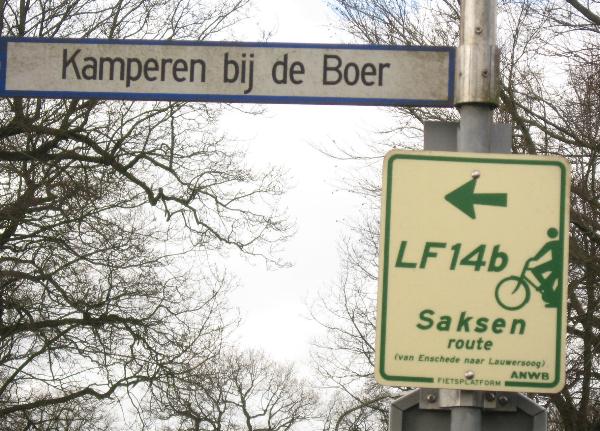
sign for a national cycle route (LF14a
goes in the opposite direction). Kamperen bij de
Boer is also useful, it directs you to a small
'campsite at the farm'
Nodal grid
('knooppuntroute')
We even have them in the north now, so you can
traverse a fair part of the country and Belgium
using the nodal grid for cyclist. Nodes are provided
with a signpost complete with a regional map and you
can plan your route by making a list of the numbers
of all the nodes you will be passing. If you buy a
recent updated cycling map the numbers will be on
the map too. If you have difficulty with remembering
the Dutch place names 36-38-41-29-42 might be easier
to follow ;) In nature reserves the roads could be
anything from tarmac to MTB style single track.
Things to watch out for when you try to use this
system:
- the
signs are rather small and usually badly
positioned as they are stuck on any pole already
present, which makes it difficult to anticipate
forcing you to a stop or crawl at every junction
- there
might be a logical way between two nodes on the
map, but if it doesn't pass the standards by the
committee you'll have to detour or use your own
sense of direction
- sometimes
there will be (once) an easily missed 4" by
6" sign saying that to reach the next nodal point
you have to follow some other signposted route
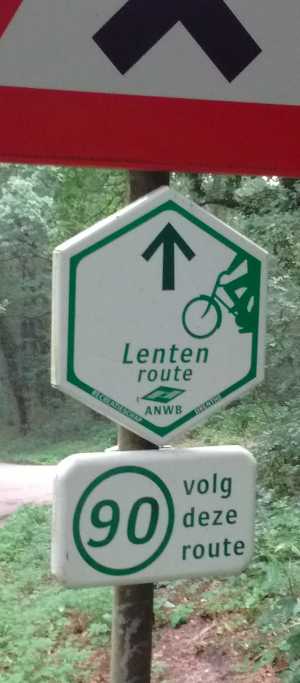
'
Follow this route' a sign designed to ensure you get
lost!
Routeplanner
The Fietsersbond (cyclist union) has a highly
recommended route planner for cyclists online. You
can choose fast or scenic routes with lots of
options and there is a language option too. You can
print out the track of save it as a file for your
GPS or google maps.
It is all here:http://www.fietsersbond.nl/fietsrouteplanner/
Road
maps.
The whole country fits on a single road
map 1: 250000 (4 mls/") If bought at a red and
yellow petrol station, price and quality will be
quite reasonable. Smaller scale maps exist, but if
you go north-south you'll need quite a few. Getting
lost in the Netherlands is probably possible, but
before long you'll run into one of the 17 million
Dutchman who are eager to show off their English.
GPS
If you prefer a map for your GPS download the free
'Openfietsmap' at http://sites.google.com/site/openfietsmap/
By all reports this one is miles better than
anything you can buy! Not surprisingly as it is the
work of a Cyclist!
Hills
Most of the country will disappear if we
switch off the pumps. So not surprisingly we have
very few hills and to confuse matters more the ones
we have are often called mountains (= berg)! These
can be found in the south (The Belgian Ardennes
extend into Limburg) or scattered around the
National park Hoge Veluwe bang in the middle of the
country (Veluwezoom, Sallandse Heuvelrug, Utrechtse
Heuvelrug). Dutch racing cyclist will know all these
hills by heart, foreigners will probably fail to
spot them. And I should probably mention the
Vamberg, bang in the middle of Drente. It's a 60 m
high pile of waste with tracks for road cyclists and
MTB's, now open for the public and with a good view
from the top over the flat landscape.
Don't leave your granny gear at home though, because
what we have everywhere is Wind! The country is very
open in places and you could face a tough headwind
all day long. If you're lucky the headwind will be
dry ;).
Off-road
touring
Although the Netherlands is densely populated, it is
possible to tour off-road, We've got loads of
national forests with cycle paths and mtb-tracks,
and on dry sandy ground there will still be quite a
few farm tracks and gravel roads which haven't been
paved over. You will find these tracks along the
eastern border with some outcrops inland, notably
the Hondsrug (roughly the line Groningen-Emmen) ,
the Veluwe (Arnhem-Amersfoort) and the province of
Brabant. Surface will be sand (anything from
hardpack to dunes), often criss-crossed with tree
roots. Down south there is some possibility of rocks
& clay (Limburg=Ardennes) If you play the
internet you can probably dig up some suitable
tracks. North-south is I think 600 km's
Climate
The Netherlands have a sea climate, heavily influenced
by the North sea and the gulf stream. Winters
will be mainly wet, cold & windy (barren fields
don't provide shelter), and it will take some time for
things to warm up in spring, with that mass of cold
water about. Campsites will probably be closed
November-March, if only to prevent the taps from
freezing up at night. Most will open up around Easter.
April-October the weather will be variable. You
could have a week of showers, but a month of no rain
whatsoever and splendid sunshine is possible too. A
rainy day could be anything: single shower in the
morning and fine for the rest, continuous drizzle or a
fresh shower the moment you've dried up. Outside
summer expect the mornings to start cold with lots of
condensation in lower areas. Watch the long range
weather forecast and bring a rain jacket or more, And
some dry socks.
Talking
Dutch
Main language is Dutch, which is spoken in a great
many dialects and regional accents. No need to
take a language course yourself, it's pretty hard to
leave secondary school here without some understanding
of English and the TV always had subtitles. Just be
prepared for a fair bit of accent, the full use of
Dutch grammar and a total lack of please and
thank you as that is far less common in Dutch
than in English language societies..
Place
names
Many place names harbour geographical clues which
might give you an idea to what to expect. Water has
always been a concern, so the higher ground was
inhabited first and that was where the main roads
were. And if you wanted to retire in the country you
didn't build your mansion in a marsh, but along a
nice river like the Vecht for instance or on the
high ground. So a few meters above or below sea
level will result in a markedly different landscape.
Some clues:
| Veen:
|
marsh,
so probably no high ground |
| Zand:
|
sand, probably a bit drier |
Hoog, laag
|
High, low, so Hoogeveen is the
highest point in boggy surroundings
|
| Bos,
wold, loo, holt: |
forest
|
| Dam |
a dam, ie a water crossing, ie Amsterdam,
crossing the Amstel, Rotterdam crossing the
Rotte etc
|
| Voorde,
-foort |
ford, as above |
| Berg |
hill, 'mountain' |
| Til |
bridge |
| Wierde,
terp |
dwelling
mound, found in coastal areas and near
rivers
|
Waard
|
Flood plain, so expect to find a
river and low ground
|
| Meer
|
lake |
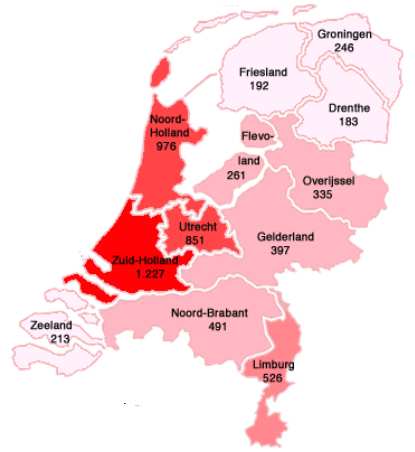
population
density
Where
to ride
As with almost any country, if
you ride up and down the country there
is quite a bit of variety to be found. Variety as in
landscape, architecture, culture and even
climate. As a rough guide, the south is
Catholic, and the dour Calvinists are up north;).
The most densely populated bit is the 'Randstad'
(the mid west bit comprising Amsterdam, Rotterdam,
The Hague, Utrecht) which is also where you find the
most international known tourist attractions, No
problem riding your bike there as there are plenty
of cycle paths and amenities, but it won't be quiet
as there is just too much going on. Coastal
area's are mainly flat, with dunes & beaches
along the north sea coast from the Hague to the isle
of Texel and beyond. Pop over along the
Afsluitdijk (easier said than done, see the note on
the closure below) , and along the northern coast
(Waddenzee) there are no beaches, unless you hop
over to one of the many islands. The islands are not
very big, but some on the left are interconnected by
tiny ferries which take bicycles. The province of
Friesland is pretty wet, so loaded with ditches.
canals, -open- bridges, lakes and boats. Frisians
have their own language, but they are pretty relaxed
about it, and there are lots of historical little
towns to visit. Groningen is mainly farming country,
and wide open. So open in fact that on fridays you
can see Sundays visit coming ;). But
plenty of small roads with little traffic. 100-150
years ago there was a lot of wealth going round, so
there is some impressive architecture (Try Usquert
for 'Amsterdamse school') and some fine unmolested
church organs. But you'd better hurry, because
earthquakes caused by the winning of natural gas
take their toll, with no chance of fair compensation
for repairs. Going south along the German border,
the landscape will offer more protection with
hedgerows and maybe even small woods or gentle
hills. For cycling Twente & de Achterhoek ( the
eastern parts of Overijssel & Gelderland) are
pretty nice. All the way down south in the province
of Limburg the hills will be tougher, as you
then run into the Ardennes and too many cafe's with
'vlaai' and excellent brews! Continuing the circular
tour Brabant isn't too bad but spoiled by too many
pig farms and maize fields. Zeeland has plenty of
coastline and is geared to German tourists, but you
might find the infrastructure (put up after the
flooding in '53) to keep the sea out interesting.
The old provinces in the middle (Utrecht,
Gelderland, Overijssel) are fine for cycling, but
the reclaimed land along the IJsselmeer (Flevoland,
Noordoostpolder) is pretty flat and monotonous. And
nothing is older than 50 odd years there except for
the incorporated islands.
Signposts
We have lots of signposts in the
Netherlands. Red letters on white are signposts for
cyclist (these usually point to one out of a series
of 10 different hamlets in about the same
direction), blue/white signs for motorcars actually
mention the place you want to go. Too bad you don't
know about that bit of motorway in between. Green on
white signs are also used for extra long (?) and
scenic cycle routes. Black lettering on yellow are
temporary signs used for detours, as it is common
with road reconstruction to block the whole road
instead of mucking about with temporary
traffic-lights and single file. On a bike the best
approach is to ignore these signs and press on.
Occasionally this won't work as you'll find a bridge
completely gone, but more often you' ll avoid a lot
of -illegal for cyclists- motorways and silly
detours by just walking a short stretch and asking
nicely!
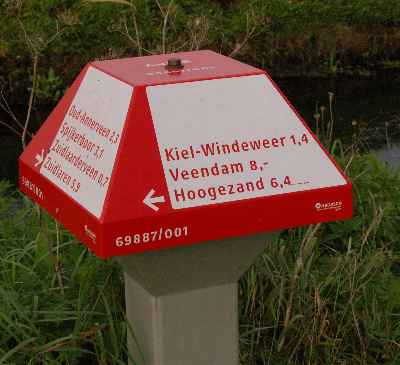 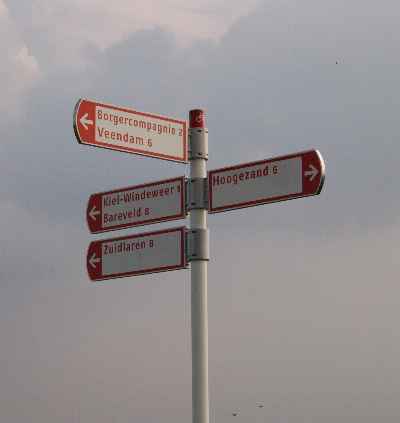
signposts for cyclists...
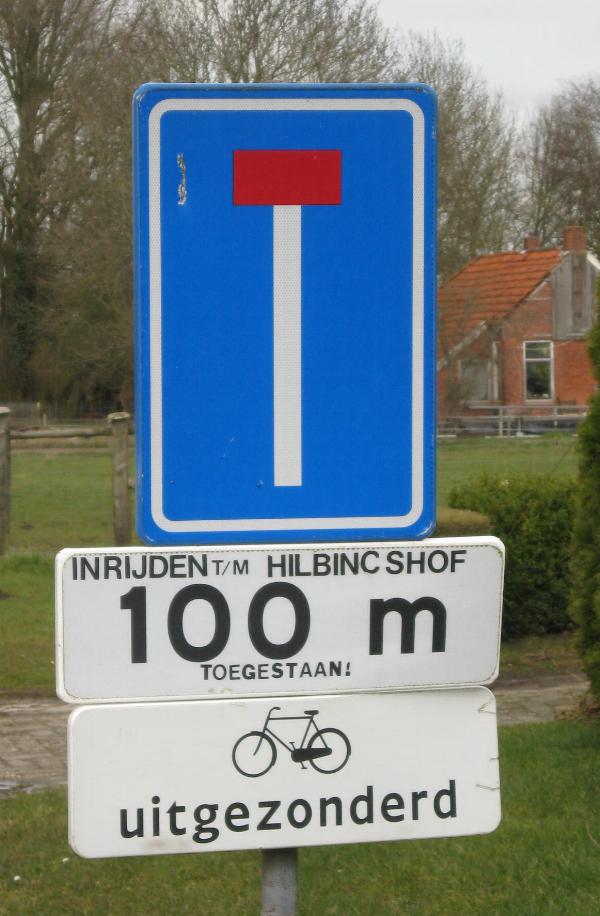 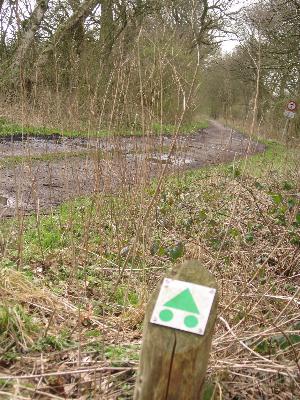
More signs for
cyclist. Left: Uitgezonderd means excepted,
so this dead end will continue as a cycle path.
Right: Not very useful for touring: this
sign is used for a MTB track
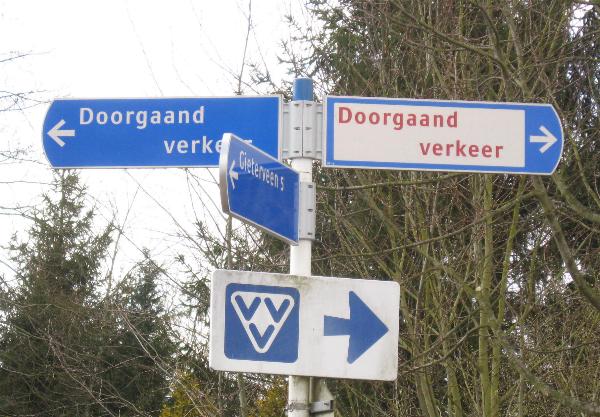
Doorgaand
verkeer = through route, cyclists should turn
right (red lettering) . This also happens to be in
the direction of the tourist office (VVV)
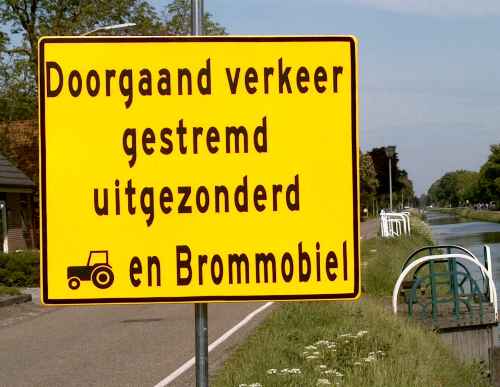
Temporary sign: doorgaand (through route) verkeer
(traffic) gestremd (blocked) uitgezonderd
(excepted). Naturally bicycles don't deserve a
mention but if a tractor can make it...
E-bikes
You know it must be weekend with a good forecast
when the E-bikes come out in force. The
typical E-bike is bought in pairs by couples who
can't ride a bike worth a damn to enable them to
terrorize a larger part of the country. They will
pull left without looking over their shoulder, come
round blind bends on narrow tracks through the
forest with the power setting on 11 and ride two
abreast oblivious to other road users. Signs to look
out for are bikes with fat hubs, ginormous
downtubes, erratic pedaling (pedal only half a turn
to prevent the electronics from cutting out, saddles
too low and bars in the sky, matching outfits warmer
than a cyclist could stand and blue rinse. They are
all deaf as a post, the mirrors are for show and
they will complain loudly that you should have used
your bell. You have been warned!
Food
In the Netherlands
supermarkets are located in easy reach for cyclists,
so you'll find them in small shopping centers in the
suburbs or in the center of the town, and not
outside the city limits on the main
road. Next to one or two
supermarkets you can also expect local merchants
like a bakers shop, or a greengrocer with perhaps a
greater choice in products. There are plenty of
supermarket chains to choose from, Lidl & Aldi
are cheap but limited, Albert Heijn (ignore the
special offers, they are loyalty card only) &
Jumbo are more varied and upmarket, and Coop/Plus is
a formula to take advantage of rural areas with
little competition. There are also local chains. You
might also want to keep an eye open for local
markets, which can be a good source for cheese,
fresh fish or vegetables.
Note that 24 hour economy in the
Netherlands refers to the working week, so if you
want to buy food you'll find most supermarkets close
at 20:00, and they won't be open on Sundays unless
the management is really clever and you're well
clear of the bible belt! (=Veluwe) In
rural area's they might close even earlier. Unlike
Germany, bakers are shut on Sunday. Smaller
shops like bikeshops are often closed on Monday,
they will be open on Saturday, but maybe without a
mechanic present. Typical opening hours are
9:00-18:00. Cafe's and bars won't close that early,
and in some cities it is possible to keep drinking
around the clock. If you're over 18 and manage to
stagger to the next place that is. Tee-totalers
might not appreciate the Dutch Coffeeshop
thoughtfully situated near airport or border,
although no alcohol is served in those places. On
the subject of coffee, many supermarkets used to
have a free courtesy coffee machine in the back of
the store but with covid many disappeared. Buy a bag
of Krentebollen (currant bread rolls) and a few
bananas, and you're good for the day.
If
you want fast-food drive past the McDonalds and go
to an authentic cafetaria. Get yourself a ' grote
patat met" (large french fries with mayonaise) or
something similar unhealthy (who cares, if you're
cycling you need all the calories you can get;) )
and save some money. Top of the bill is a 'Kapsalon'
where you can actually feel your arteries clogging
up ;) If you survive you can go for jellied
eels or fresh herrings from a street stall next!
Another thing to keep an eye out for are restaurants
serving 'Pannekoeken' ie pancakes. Great
cycling food (lots of filling options) and the
family style restaurants won't mind kids, dogs or
dripping wet cyclists. Chinese restaurants are also
an option (they are pretty big on take-away too) but
be prepared for many Indonesian dishes, as they are
heavily influenced by the kitchen of our former
colony. Tapwater will be high quality everywhere and
safe to drink.
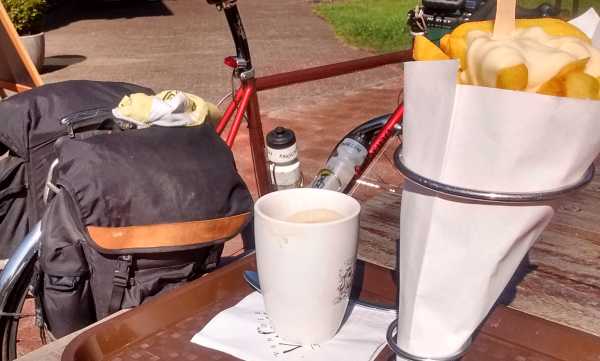
Camping
You're not supposed to camp in the wilds
or in what we consider wilderness. You'll probably
fail to spot our nature reserves because we have
nature organized. This is big business involving
committees, planning permission, designers and heavy
earthmoving equipment. Certainly not something to be
left to nature, which is why it looks
different. But if you pick your stealth
camping-spot with care you could be ok, just don't
try this in the height of the tourist season in
coastal resorts as evasion of the tourist tax is
frowned upon! Campings are probably closed
October-April but you could try WTMG. If
you decide to tour in the off-season, you'd better
bring decent rain gear. With a sea-climate being out
all day on a bike on a rainy day would not be my
idea of fun.
The latest thing is that wild camping in
our organized wilderness is now organized and
regulated too! In some forests, spots are marked
where you can pitch your tent for the night. Don't
look for it on the site of our forestry commision:
staatbosbeheer.
it is unintelligible, and knowing
Dutch doesn't make it any better.The Hiking site
has a list with place names and GPS coordinates of
the sites (click on the map (the red spots don't
mean a thing) and you get a list of the closest
spots. Pitch your tent within sight of the pole
and boil the water (there should be a well) before
consumption. Take your trash, don't build a fire
and leave within three days. Sorry,
Covid was all the excuse needed to close them down
again
If, like most cyclists, you like your campsite
simple and quiet but with a hot shower, you could
try the Natuurkampeerterreinen ie nature campsites..
You'll need a membership card (valid for up to 4
persons) and a list of sites which can be obtained
at the first campsite you visit: http://www.natuurkampeerterreinen.nl/en.
Caveat: many of the natuurkampeerterreinen are run
by Staatsbosbeheer (Forestry commision), and with
Covid as the excuse they now go for the big money
and are very bike unfriendly (with reservations,
closed short stay field etc)
Cooking
Fuels
Methylated spirit (85%) is cheap and available in
every supermarket as a cleaning product. Gas
canisters (valved and non valved) can be found in
DIY (Gamma, Praxis, Karwei, Hornbach etc) or outdoor
stores like Decathlon or Bever
Friends
on
Bicycles (Vrienden op de fiets)
If you're not the camping type you will
appreciate the foundation Vrienden op de Fiets. This
is a widespread network of people offering a room
and a breakfast for fellow cyclist for 19.00€ or
less.You'll have to join the foundation for the
adresses, but it 's only a nominal fee. They have a
website
and there is even an English language option, see
the bar at the top! Usual procedure is that
you don't reserve your lodging much in advance, but
figure out where you will end up during the day and
phone round to see if somebody in that area can put
you up that night.
Things
to
do on a bike
-
Ride
the
Afsluitdijk,
the dike which turned the Zuyderzee into the
fresh water lake IJsselmeer Depending on
the wind, this could take you all day as it's 25
km long. Sorry, the Afsluitdijk wil be
closed to cyclist for
repairs as of 1/4/2019 ,
maybe there will be a shuttle service.
- Another
tough one could be Enkhuizen-Lelystad, which goes
halfway through the IJsselmeer and which is
notorious for mosquitos (The ferry Enkhuizen-Stavoren
might be more fun, and naturally the dike is
closed to cyclists for repairs in 2018 (there is a
shuttle in the daytime). The planning is for it to
open again July 2019. Update: the works have
finished and the path is reopened for cyclists.
- Visit
Velorama,
the bicycle museum in Nijmegen overlooking the
river Waal. Another fun one if you like MTB
history is not too far away out in the sticks near
Arnhem:
MTBmuseum
- Ask
the
miller
if you can take a look inside if you spot a
working windmill, we have lots!
- Visit
Groningen,
which was once voted Fietsstad (cycling town) of
the year. The cycle paths fitted with sleeping
policemen probably clinched it!
- Ride
along
one
of our rivers (Waal, Rijn, IJssel) over the river
dike, and enjoy the timeless landscape by Rembrand
cs. (or see the originals in the Rijksmuseum
which appears to have opened again after years of
alterations, don't mention bicycle though
if you run into the director, the bike path
underneath the museum is a sore point)
- Eat
lunch,
leaning
against a Drents Hunebed (Megalithic grave tomb
made of very large stones in the province of
Drenthe)
- Take
a girl
friend home on the luggage carrier after a
night out.
- Get
your
picture
taken by one of our many speed camera's! (only a
few km's over the limit should do it, and
motorists will love you for it)
Things
not
to do with a bike
- Many
cycle
paths through the Dunes are fitted with barriers,
speed bumps and other attractions to turn away
cyclists. You might have to unload to get your
bike through the narrow barriers!
- Ride
without
lights
in darkness. Ride with a blinky in rural area's:
city cops will be happy that you have some sort of
light, rural cops might have enough time on their
hands to write a ticket! By law the lights
should be fitted to the bike, not to the person
but it has recently been officially announced that
this won't be enforced (officially not enforcing
official law is the Dutch way of doing things, and
Gedoogbeleid
could soon be a word in your language too!)
- Take
your
bike
with you in shops or restaurants, unless you're
very good at 'sorry I'm a foreigner...'
Cycle
shops
Although the majority of cycle shops
specialize in the repair (with a hammer, duct-tape and
WD40) and sales of sit up and beg bicycles, there are
plenty of racing and MTB shops who can work on a
touring bicycle. Just stop the first person on a
halfway decent bike and ask for directions. Dedicated
touring gear will be harder to find if you don't know
where to look. (If you're stuck you can always contact
me for suggestions)
Renting
a
bike.
Some shops rent out decent recumbents. See
www.ligfiets.net
for details. At stations or in tourist resorts it is
often possible to rent a Dutch roadster. I know of
no place where you could rent a decent touring bike.
You could try buying a second-hand bike (The Dutch
version of Craigslist is at Marktplaats.nl) or if at
a shop negotiating to have them take it back after
your trip. (Edit: Sneltweewielers.nl in Utrecht
rents touring bikes, Bike4travel.nl (Rotterdam)
rents tandems and trailers)
Holidays
We have more holidays than we know what to
do with, and they are all thoughtfully positioned
late spring/early summer. The anniversary of
our Queen (30-4) is a nice example as the real
anniversary of our current Queen Beatrix is
ignored because of the possibilty of inclement
weather. We've stuck to her late mothers birthday
as it makes so much more sense! Update ,
we have a king now, and our Kingsday is now on 27/4,
the actual birthday of his Royal King Willem
Alexander. (Queen Beatrix & consort being
a bit more sensible than her dear departed mother ;)
)
Money
The usual way to pay for
your shopping is either with cash (euro's) or by
debit card (Maestro) with a 4 digit PIN. Most shops
will round off the due amount to the nearest 5 cents
as the 1 and 2 cent pieces are a pain. Credit cards
(which are expensive to process) are not as
widespread as debit cards. Restaurants and shops
aimed at tourists will probably accept them, but
check (decal on the door?) if they are acceptable.
Some supermarkets might have pin -only check-outs
which is why the queue is shorter.
Phones
Due to the widespread use of cellphones,
public phones have all but disappeared . There were
440 left at the last count (2015!) in the whole
country, mainly at airports or city-centres. For Non
-EEC residents, if you bring a cellphone make sure
it takes a sim card and doesn't have a sim lock so
you can use a locally obtained prepay card. Even
then phoning home might cost a fortune, but
receiving one won't be so bad. Texting will be
cheaper than voice.
Internet
I'd try a public library or asking your
host. And many people have wireless, so you could
stumble on an open connection by accident;) Many
cafe's etc will also offer free wifi.
Emergencies
Dial freephone 112 for police, ambulance
or fire services. If dialed from a portable phone
you are routed to a national switchboard, and they
can now locate your phone pretty accurately. Expect
the operator to be able to speak -basic-English.
Medical
care
Doctors are well hidden
behind answering machines and are often organized in
collectives to ensure they have enough days off.
Don't waste too much time trying to find one and
head for the emergency department of any hospital.
Once you've found one, unlike US doctors a Dutch
physician will not try to prescribe the entire
contents of the pharmacy to cover every unlikely
eventuality, even though the same medication will
cost a lot less here ;).
Power
If you want to bring electric chargers or whatnot,
mains is 220-240V AC. You'll need an Euro style
plug, the kind with two round prongs 3/4" apart.
Natural
dangers
Biggest natural danger is probably
drowning if you haven't learned how to swim. If you
accidentally fall in (too many beers, a pee &
canals don't mix!), first try if you can stand. Many
canals aren't very deep.
There
aren't many dangerous plants if you leave the
mushrooms alone, but touching stinging nettles will
be very unpleasant. Especially after some rain you
will spot them hanging out over the cycle path,
looking for a bit of leg. Rub the offending spots
with the crushed leaves of ground ivy or plantain.
Avoid Bereklauw (Hogweed) too.
Animals: Dutch wild animals are pretty well behaved.
In theory you could get run over by deer, catch
rabies near the German border, get savaged by a wild
boar (lots of them in the national park Hoge
Veluwe), get bitten by an adder (poisonous snake) or
get stung by bees but you would have to work at
it.The wolves are mainly terrorising sheep. The
exception are ticks, many of which are infected with
Lyme's
disease.
If
you are bitten by one remove it as soon as possible,
within 24 hrs. If you subsequently notice any red
discoloration spreading around the bite or get
flu-like symptoms consult a doctor straight
away. Another pest in the south of the country
but spreading north, and active from the middle of
May till July can be the Oak processionary, whose
poisonous hairs can cause asthma and skin
irritation. You might encounter warning signs "Processierups"
taped around the trunk of infected trees. Another danger
of late coming from the trees could be an airstrike
by a buzzard protecting its nest. If they are really
aggressive the council will put up signs so you know
what hit you..
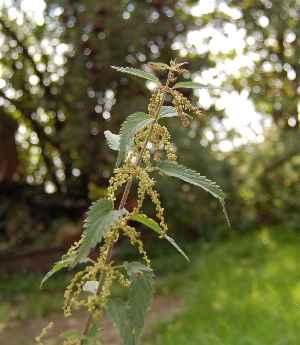
Stinging nettle, aka brandnetel
Other dangers
About 200 people were murdered in the
Netherlands in 2005, and about the same number of
cyclists died in a traffic incident. In other words,
if personal safety is a concern don't go home. Some
neighborhoods will not be as nice as others, but we
don't have no-go zones as in the USA or
France.
|













